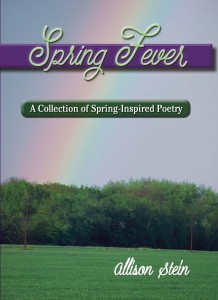by Allison Stein
“To accomplish great things, we must not only act, but also dream; not only plan, but also believe.” Anatole France’s words reverberated in my heart as I gingerly selected a copy of my new poetry collection, Spring Fever, from the box that the FedEx truck had just dropped off. I recalled the time when my chapbook was a mere aspiration, when the moment of holding the finished product seemed so far away. But that time had come, and as I savored this beautiful memory, the possibilities and hopes swirling in my mind mesmerized me. I had finally grasped the goal I had been fighting to achieve, finally overcome the obstacles that threatened me, finally made my dream come true. Undoubtedly, the day I first felt that glossy cover and flipped through the crisp pages of my new book, the rewarding journey of self-publishing took my breath away.
Challenges throughout the process were inevitable, but to someone who finds writing as empowering as I do, the endeavor of creating a book is extremely fulfilling. My goal began to transform into reality when I started working on the first draft a couple of years ago; at times, even I struggle to believe that those first scribbles in the margins of my notebooks have developed into the tangibility a book offers. Early on, however, I already imagined the theme of my second poetry collection to be spring. With this fine-tuned scope, I was able to focus on capturing the joy, passion, and faith embedded into the season. Moreover, this approach allowed me to improve the cohesion of my book as a whole; ideally, each poem in the compilation collaborates with the others. Not only did I strive to encapsulate the beauty of spring in words, but I also aimed to convey emotion and express memories and dreams. For as long as I can remember, I have possessed an unspoken – yet lucid – understanding that writing is liberating, and I hope that through my work I can share that freedom with others and encourage them to pursue their dreams. Connecting words to form stanzas and arranging stanzas to fuel a poem, I have immersed myself in an art that I wholeheartedly believe in – an endeavor from which I’ve undeniably discovered fulfillment.
In addition to writing propelling me forward, I have realized that editing is imperative to the self-publishing process. Revisions began with self-editing, a chance for me to scrutinize my work, to determine which poems showcased the book’s potential and which needed to be replaced as well as what aspects of individual poems excited me and what facets required improvement. The project expanded as I sought the opinions and advice of others; for example, I asked one of my mentors to critique my manuscript, and she offered me valuable insight. Furthermore, my mom contributed to the book by helping me strengthen my poetry through revision and giving me guidance about the steps of successful self-publishing. I definitely learned a colossal amount from editing my chapbook; the experience was an opportunity to explore my work on a more intimate level than a first draft allows. I was elated to see the collection starting to take shape, but I knew, too, that an enormous – and, at times, intimidating – margin continued to separate my disorganized stacks of papers and the professional book I envisioned.
Aiming to close that margin, I began to contemplate the lay-out of my chapbook. I am still awestruck by the idea that self-publishing allows a distant dream to become palpable, to become a gift I can share with others; with this mindset, I focused on fonts and design elements that would impact the presentation of my poems. For one, I divided the book into six chapters, each section having its own theme. After I decided on the order of my poems, my book designer, Julie Purdy, emailed samples of both the cover and the interior pages; my mom and I chose styles similar to those of my first chapbook to display the continuity between the volumes while also selecting features that made Spring Fever unique. I was psyched when I saw the talented work Julie had done on the inside of my book, but the cover she had created, which illustrated a rainbow that I found enchanting and believed would be a terrific complement to my poetry, excited me most. Once the designing was finished, I knew that I had reached a pivotal moment in the course of publishing Spring Fever; at this climax, my abstract dream solidified, and my fragmented aspirations connected.
On March 6, that connection strengthened. My unbound proof arrived from DiggyPOD, the Michigan company that had printed my first chapbook. When I saw how brilliant the chapbook’s cover design looked, how enticing and pristine that rainbow appeared, I was astonished, but I knew immediately that my poetry belonged there. The memory of my books being delivered about a week later still echoes in my mind. My heart beating fast, I tore into the box. Seeing Spring Fever was magical, and the physicality of the collection seemed to cement my ideas: I could finally hold in my hands the dream I’d been striving to grasp.

